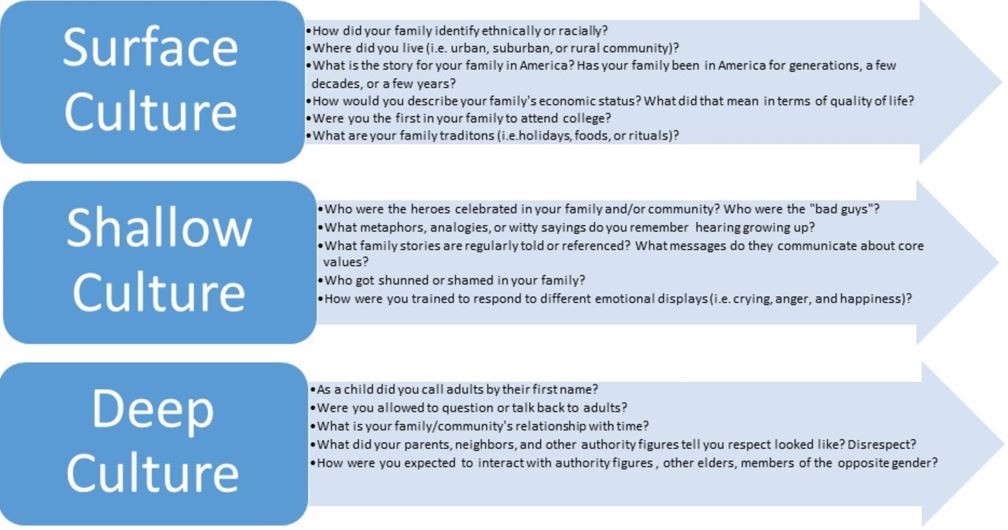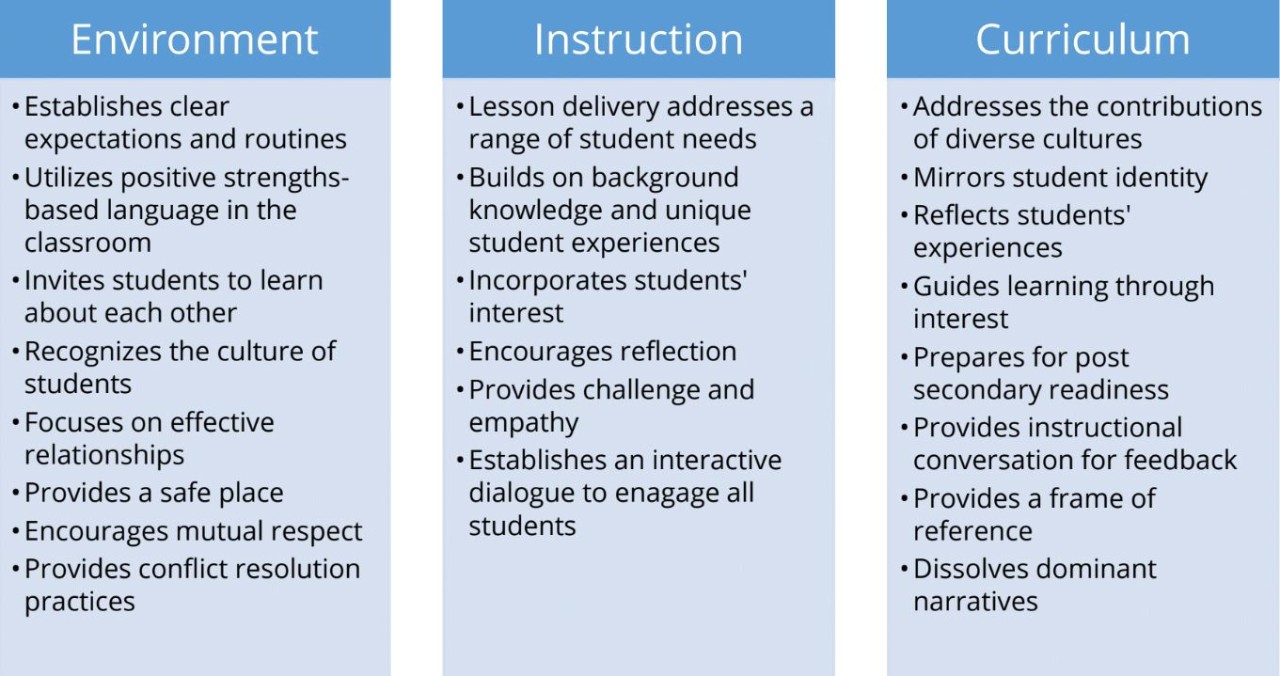Culturally Inclusive Practices
Students today are increasingly more diverse in abilities, cultures, language, and learning modalities. As Tennessee schools move toward becoming more inclusive of all students, educators must work together to create a system of support that promotes learning and belonging for all.
Inclusive practices are instructional and behavioral strategies that influence academic and social-personal outcomes for all students in general education. There is no one size fits all strategy or a special tool kit to becoming culturally inclusive. Rather, educators must see inclusive practices as an approach to developing safe learning environments, thoughtfully planning instruction and strategically selecting and aligning curriculum that meets the needs of students.
The following key areas are critical to the development of culturally inclusive practices.
In culturally inclusive environments, commonly referred to as culturally responsive environments, schools consciously build a place in which heritage and experiences of all student communities and cultures are treated equitably and with respect. Culturally responsive environments foster appreciation for all, including student families. There are a wide range of classroom practices and activities that can help students learn about different cultures as well as help foster an appreciation for diversity. For example, some classroom practices may include: providing students with opportunities to share stories of their life, showing students everyday photos of people from different ethnicities making a positive impact when opportunities are presented during instruction, welcoming guest speakers making positive contributions in the community into the classroom from diverse backgrounds, and setting up bulletin boards or work walls in the classroom with purposeful intention to learn about the cultures in the classroom or the school.
Activities focused on developing safe and welcoming environments include:
Communication and use of Language
Positive language is a key driver in establishing a classroom community that learns together, grows together, and supports one another. Language that uses words and tones that display faith in student learning tells students that the teacher believes in him/her and his/her academic capacity. Using powerful and effective teacher language takes practice and awareness. Here are some examples to demonstrate a few adjustments to the words used in a classroom:
Your Words Matter
Non-verbal Communication
Nonverbal communication is an important component of communication. Nonverbal communication includes actions that do not involve spoken languages, such as tone, touch, personal distance, facial expressions, eye contact, turn-taking, and gestures. Nonverbal communication is complex and no one is expected to be an expert. For example, in some cultures, loudness may be associated with anger or agitation while in another culture it may convey a neutral message. In order to develop an understanding of how students respond to nonverbal communication, educators can investigate communication patterns in culturally diverse groups.
For more information on learning about non-verbal communication for supporting diverse students in the classroom please see resources such as:
Nonverbal Communication: A Quiet Path to Children’s Engagement
ALTELLA Nonverbal Communication in Diverse Classrooms: Intercultural
Competence Considerations for Supporting English Learners with Significant Cognitive Disabilities
Body Language: Creating Bonds
Questions to Consider
To further understand nonverbal communication in diverse classrooms, educators may want to consider the following questions:
- How can I learn more about nonverbal communication across cultures so that I can best support my students in my classroom?
- Which cultural characteristics of nonverbal communication should I take into consideration when working with each individual student?
- With whom should I collaborate to generate a better understanding of my students’ nonverbal communication patterns and needs?
Classroom Support
- Indicate that you are giving the student your full attention. This may mean sitting up straight or adopting an open posture (not with crossed arms or legs) and leaning slightly toward the student.
- Use open-handed gestures when inviting the class to speak or join in, since in some cultures it is offensive to point.
- Find out whether students are comfortable with handshaking or sitting close together, as preferences for physical contact and proximity can vary.
- Do not interpret a lack of eye contact as a lack of attention, as some cultural groups avoid direct eye contact as a sign of respect.
- Quick note: In some cultures "yes" or a nod of the head might mean "I hear you" but not necessarily "I understand you".
Building trust and rapport with students is one of the first things to consider when building relationships with students. Getting to know students is one of the key components of a culturally responsive classroom community. Understanding students’ cultural, academic, and linguistic experiences are established through authentic connections and true relationship building. Students have to believe teachers care about their well-being as well as their future endeavors.
Questions to Consider
To further understand how to establish relationships within a classroom that has diverse experiences, cultures, and languages, an educator may want to consider asking and answering the following questions:
- What are the varied cultures and experiences in the classroom?
- How do I find out about my students’ cultural backgrounds in a respectful manner that provides me with accurate information?
- How do I come to understand my own cultural thoughts and beliefs?
- How do I incorporate students’ families into my educational practices?
- Who can support me when I do not understand why my students are behaving in a particular manner?
- How do I build a trusting classroom environment where everyone feels welcome?
- How can I help my students become more engaged in classroom lessons?
- What discipline practices are appropriate?
For more information on building positive rapport with students please see the following resources:
Building Relationships with Students
Learning About Student Backgrounds
Getting to Know Students Deeply
Discipline
Today's diverse learners enter school with a variety of expectations and behaviors. Students have different reactions to the classroom environment that are directly related to their levels of both comfort and skills. Comfort levels can be strengthened by creating a classroom environment of mutual expectations and respect. It is important to directly teach expectations and behavioral skills in a safe environment that engages in healthy conflict resolution strategies.
Characteristics of Culturally Responsive Discipline
- Low level infractions receive low level discipline measures; high level infractions receive high level discipline measures. The disciplinary action is appropriately aligned to the level of the infraction.
- All students are held to the same standards and rules so as to not create a sense of privilege amongst one group of students.
- Disciplinary measures are implemented based on the infraction, not the student.
- If a student breaks a rule, he or she receives the same disciplinary action as any other student.
Question for reflection about problem behaviors
- What problem behaviors are occurring?
- When are the problem behaviors occurring?
- Where are the problem behaviors occurring?
- How often are the problem behaviors occurring?
- What skills (i.e., conflict resolution) have been taught to help make decisions about appropriate behaviors?
- How does the district and/or school communicate discipline policies and practices with parents both before and after any disciplinary incidents?
Helpful Resources
A Classroom Where Everyone Feels Welcome
Community Walks Create Bonds of Understanding
5 Keys to Challenging Implicit Bias
Safe Schools Training: Restorative Practices
School-Home Communication Strategies
Mapping Your Cultural Reference Points as an Educator
Identify and Map Your Cultural Reference Points
Teachers who are successful in their work with culturally diverse students accept and understand themselves as cultural beings. Having cultural reference points helps shape mental models about the teaching and learning of diverse students. Use the questions below to establish some clues about your own culture. As you develop a greater sense of your cultural frames of reference, you begin to have a clearer picture of your cultural self. This may include what drives you, what shapes your worldview, as well as what influences your teaching.

Culturally responsive teaching (CRT) is the foundation for establishing an inclusive learning environment for all students. CRT responds to the diversity of students within instructional activities. To develop instruction that is culturally responsive, educators must be proficient in relating to their students. This knowledge of students is taken into account for instruction, curriculum, and assessment in order to meet the needs of all learners. CRT takes into consideration students’ unique stories and experiences, accomplishments, and struggles that may shape a student’s perception of learning. These considerations help plan and lead instructional activities as well as help determine the structure of how students will engage within a given task.
How do I learn more about planning culturally responsive instruction?
How to Get the Most Out of a Diverse Classroom Library
Talk Less So Students Learn More
3 Ways to Use Music in the Classroom
Using Culturally Responsive Lessons to Boost Engagement
Culturally Relevant Curriculum and Culturally Responsive Schools Toolkit
The Brain and Learning
Learning is a physical process in which new knowledge is represented by new brain cell connections. Just like computers, all brains have a default setting that acts as its prime directive regardless of diversity in race, class, language, or culture. Cultural values program the brain on how to interpret the world (e.g., determining what a threat looks like and will bring a sense of security). The basic structures of the brain are important to understand to identify how recording and cataloging information through experiences takes place while learning. It is imperative to understand how to build positive social relationships that signal to the brain a sense of physical, psychological, and social safety so that learning takes place.
Culturally responsive curriculum is a critical element in developing an inclusive environment and instruction. A balanced curriculum adhering to the Tennessee Academic Standards should empower students to value all cultures, not just their own. A culturally responsive curriculum invites students to see their identity in the learning process. For some standalone curricula, complementary materials may need to be embedded to address the contributions of diverse background experiences as well as diverse cultures.
The components of a culturally responsive curriculum should:
- Acknowledge the legitimacy of the cultural heritages of different ethnic groups
- Connect school and home experiences
- Use different instructional strategies to address all learning styles
- Teach students to value their own cultural heritage and that of others
- Incorporate multicultural materials into the curriculum
(Dr. Geneva Gray: Culturally Responsive Teaching: Theory, Research, and Practice
(Multicultural Education Series) 2nd Edition) 2010
Helpful Resources
Creating a Diverse Classroom Library
Universal Design for Learning
All Children Challenged and Equipped for Success in Schools (ACCESS)
References and Resources:
Culturally Relevant Curriculum and Culturally Responsive Schools Toolkit
Cultural Inclusion
Culturally Inclusive, Culturally Responsive
Diversity Toolkit: Cultural Competence for Educators
Designing Culturally Inclusive Classrooms
Inclusive Schools Network
Practices for Creating A Culturally Inclusive Classroom
